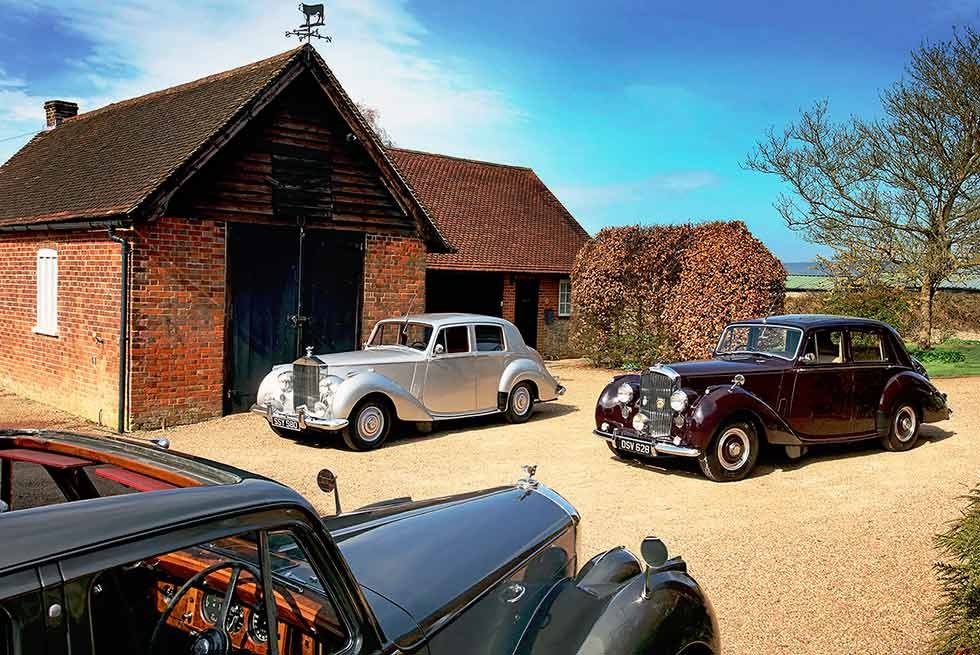
Mass-produced in Crewe Comparing Standard Steel Bentley MkVI, R-type and R-R Silver Dawn. Bespoke tailoring, but off the peg. Martin Buckley tells the story of how the elegant Standard Steel body helped Rolls-Royce and Bentley to survive in the bleak, early post-war economy. Photography James Mann.
A distant relative of mine had a Bentley MkVI. He was a jeweller (I think) and was still running this grey, slightly frilly 25-yearold car in the mid-1970s when, presumably, he could well have afforded something much more modern. I only saw the Bentley the once – in the distance, at some family do – but I was instantly attracted to it. This was an era when cars of that generation had almost completely disappeared from the streets. You still used to see the occasional 1950s Daimler or Humber, although somehow all they had to offer was pomposity on a one-way trip to the banger-racing circuit or the breaker’s yard. The Bentley exuded a presence and a dignity that was almost eternal. It seemed like a gateway to another world.
Unfortunately, my MkVI reverie was soon interrupted by my dad: he rounded on this poor old Bentley that Sunday afternoon, dismissing it as a worthless “shed”, and wouldn’t even let me cross the road to look at the thing. It was a fleeting moment – not worthy of ringing Childline, even by today’s standards – but one that has stuck with me. I just couldn’t understand this studied lack of interest from someone who professed to like “interesting” cars. Rusty or not, that MkVI was certainly interesting.
Dad was, I suppose, old enough to recall the Standard Steel Bentleys when they were symbols of grey-haired authority. To him, aged 35, it was just an old man’s barge with nothing to offer but thirst and the pitying looks of the ’70s punters in Cortinas and Avengers. On the other hand, he could also remember when that old MkVI was the best saloon car in the world. Probably.
The introduction of the MkVI Bentley was a delicate moment in the history of Rolls-Royce as a maker of automobiles. The firm had emerged into a post-war world carrying the burden of national pride more heavily than the make had ever done before, the Merlin engine having famously helped to ensure that Britain emerged on the winning side of the recent conflict.
This was also a world where nobody seriously questioned the notion that whatever vehicle emerged from Crewe post-1945 would be ‘the best in the world’. That’s taking into account how meaningless the phrase was becoming when applied to products as increasingly diverse as the modern motor car. It was a lot to live up to, especially when the pressures of long-term survival, behind the scenes, had pushed the revered product in a new direction. That idea to some people might have seemed suspiciously banal and mass market: ready-made ‘Standard Steel’ bodywork.
In fact, while it is tempting to see the introduction of factory coachwork as a reaction to the austerity measures of the times, the truth is that Rolls-Royce would almost certainly have gone in this direction had there not been hostilities. It was in talks with Pressed Steel about the new post-war bodies in 1944, part of a process of rationalising chassis and engine designs that was already well under way in 1939.
For an investment of £250,000 in tooling, it was calculated that the firm would need to sell 5000 cars in five years to break even. It was a risk, of course – it had, after all, taken the chassis division 20 years to sell that many units before the war – but a not unreasonable one.
There would be no shortage of customers. New cars of every kind were in short supply and there was money about: the flipside to the grim measures of the time was that there were also lots of wealthy people who, far from being crushed and exhausted by the war, had done well out of it financially. These tycoons, across the UK and the still-existing colonies, were more than willing to spend £2997 (about 90 grand in today’s money) on the ultimate luxury saloon.
It wasn’t too much of a status symbol, though. Rolls-Royce was aware of the sensitivities around its name in an era of socialist rule – Clement Atlee’s Labour had won the 1945 election – and it was considered wise to focus attention, at least initially, on a Bentley version of the new post-war model.
Enter, in 1946, the MkVI. The first cars were delivered in September and the order books quickly filled, leading to a three-year waiting list. The dignified shape was derived from prototype bodywork seen on the pre-war MkV and it was the first production Royce or Bentley with faired-in headlights. Running 16in steel wheels on a 10ft wheelbase, the riveted, channel-section ‘rationalised’ chassis was a shorter version of the frame found under the Silver Wraith, the grander cousin of the MkVI, which was exclusively coachbuilt in wood and aluminium.
The MkVI cost roughly 30% less than a Wraith – thanks to the economies of scale offered by its in-house bodywork, which was fabricated in Oxford and delivered in the raw to Crewe. There, at Rolls-Royce’s former wartime aero-engine shadow factory, MkVIs were sprayed and trimmed in specially constructed workshops alongside the main buildings.
Later these bodies may have became famous for their propensity to rust, but Rolls-Royce was determined that its completely in-house model would be painted and upholstered to standards that rivalled the best of the coachbuilt versions.
Certainly, this was a more engineered shell than any of the bespoke types: lighter, simpler and easier to quality control than the range of handbuilt bodywork from Mulliners, Park Ward, Hooper, James Young and others. That customers were satisfied with their Standard Steel MkVIs is evidenced by the fact that out of the 5201made only 832 had coachbuilt bodies. And who wouldn’t have been well pleased with a luxury conveyance such as this in 1946? Here was a five-seater saloon that could cruise in the mid-80s and top 90mph thanks to the unobtrusive strength of its B60 4¼-litre straight-six, the middle child of a simplified family of four-, six and eight-cylinder in-line F-head (inlet over exhaust) units developed during WW2.
Crewe didn’t quote an output figure for the Bentley version, but on twin SU carbs and a highlift, helical-gear-driven camshaft, the power is thought to have been 146bhp at 4000rpm. It was produced with silky refinement – thanks to a meticulously balanced crankshaft – and deployed through a right-handed manual gearchange that set new standards of refinement.
Those who asked where their money had been spent did not have to look far on the MkVI. Even if they were not impressed by the walnut veneers, the West of England Cloth headlining and the best Connolly Vaumol leather, there was the fact that one tiny Yale key served the entire car. They could also not fail to have noticed the one-shot lubrication system for the suspension and steering, the ‘hard’ and ‘soft’ damper setting for the rear suspension (driven by a pump from the gearbox) the handsome toolkit or beautiful, enamel-black presentation of the engine.
The MkVI became the R-type in ’1952; logically, it should have been the MkVII but Crewe didn’t want to share its nomenclature with Jaguar. With the ‘long boot’ treatment and extended rear wings (less spats), the R-type had a more graceful profile than its predecessor, with a liftup aluminium bootlid giving access to the significantly increased luggage space, up from 6 to 10½cu ft. Its styling modifications were attributed to John Blatchley, later responsible for the Silver Cloud and the Silver Shadow.
These long-tailed versions tend to be associated with the introduction of the ‘big bore’ 4½-litre engine – with its full-flow oil filter and siamesed 3½in bores – but this 156bhp unit had been fitted since July 1951, pushing the MkVI’s performance into the 100mph class and lopping 1.4 secs off the 0-60mph time.
The R-type also featured the introduction of automatic transmission as an option. Rolls- Royce was never above adopting – or adapting – the best of what other companies had to offer and it considered General Motors’ four-speed Hydra Matic to be the finest automatic ’box in the world. The first 100 or so transmissions were built by GM for Crewe, but they were soon being produced by Rolls-Royce with its own refinements. The R-R boffins apparently machined one GM ‘rough spot’ down to such a fine tolerance (when developing the prototype) that the ’box wouldn’t work at all afterwards. It made Hydra Matic units under licence until ’1967.
Meanwhile, at the World’s Fair in Toronto, Canada, in 1949, a Rolls-Royce version of the Standard Steel was introduced. The Silver Dawn was earmarked for export only and was the first left-hand-drive Rolls-Royce since the early 1930s. It was a model aimed squarely at the American market where buyers wanted an actual Rolls-Royce for their $14,000, not a Bentley. The truth was that not many people knew what a Bentley was in North America.
With 22 fixed shutters (another Rolls-Royce first) and a kneeling Spirit of Ecstasy, the Dawn’s radiator was adapted to the proportions of the body but, apart from the shape of the bonnet, all the panels were shared with the MkVI.
The £60,000 price-tag on Ghost Motor Works’ immaculate Silver Dawn perhaps reflects the model’s rarity. Just 761 cars were produced between 1949 and ’1955, of which this is supposedly the only left-hooker on sale in Europe. The fact that it’s had £40,000-worth of specialist work since being brought back to the UK from California 20 years ago probably helps.
The Bentleys come cheaper, which is a little unusual in the normal scheme of things. The Tudor Grey-over-Shell Grey MkVI is a five owner former show winner that’s up for £37,000; the Royal Garnet R-type automatic comes in at £45k, complete with £66,000-worth of invoices. The driving differences between the three are surprisingly marginal, whether manual or auto, Rolls-Royce or Bentley. Once you have reversed yourself through the suicide door and thrown back the big ‘sliding head’ sunroof for extra light – the interiors are quite gloomy – you find yourself in narrow cabins facing a plain but stylish dashboard, the Dawn’s being closer in layout to a Silver Wraith with four separate smaller dials. In all versions of the model, you find the classic R-R switch box and that big, three-spoke black wheel that, on the MkVI, still boasts hand throttle, timing and mixture controls.
Other anachronistic items include trafficators and pushbutton starting without the key if necessary. So you could leave the car with your (potentially) light-fingered garage man, but he couldn’t riffle through your boot or glovebox. In fact, there are Yale locks on everything, from the toolkit to the bonnet – as if there was a paranoia about the ‘lower orders’ pinching bits off them. Such features place the Standard Steels firmly in an early-’50s world of bomb sites, ration books and baggy demob suits. Even the HMV long wave/medium wave radios look as if they would only ever transmit a Terence Rattigan play on the light programme.
These details are a huge element in the charm of these cars, although also an irksome reminder of how old they now are. Old, and also surprisingly compact being from an era when even the very wealthy were not quite so fat and flabby. Still, they are roomy cars in the back once you have – again – reversed yourself in. Everything is fitted and finished to an impeccable standard, with ‘companions’ in the C-pillars, writing desks in the backs of the seats and a general air of what road testers used to call ‘well being’. Most of these vehicles were ‘owner-driver’, but it was possible to specify a division from 1949.
The three-pedal MkVI – with its amazingly original, near-70-year-old red leather and onepull ‘chauffeur’s window’ door glass – has the most immediate appeal on the road. Once you have negotiated your trouser leg over the right-hand lever and sorted first from reverse (some adjustment needed there), the satisfaction in the well-oiled, mechanical feel of the shift is deep indeed, particularly because the clutch is relatively light and harmoniously fluid in action.
All variants encourage smoothness and restraint, so that in the MkVI it soon seems sensible not to bother with first because the car pulls away just as well (and more quietly) in second. The automatics have even more sophisticated manners, of course – apart from the ‘lumpy’ gap between third and top – although their main benefit is making the cars, with their rear blind spots and hefty low-speed steering, just that bit easier to manoeuvre in everyday situations.
The Silver Dawn, with its bench front seat, has the most relaxed character and has the least performance, but the difference is not dramatic. Its version of the straight-six has a single Zenith carburettor (later Stromberg) and delivers a dignified, ceremonial purr at all times. This one’s modern power steering conversion is so unobtrusive that you don’t even notice it.
The Bentley’s standard set-up, in contrast, gives your pectoral muscles a good workout. You really notice it when you are on your umpteenth three-point-turn for the photographer’s panning shot (the profile view as you drive past) or simply heaving against the understeer on a roundabout.
Which is not to say that the steering is not reasonably accurate or that, in long curves, the cars are not impressively stable; they just were not put on this earth for being casually flung around. They don’t look or feel good doing it. They are about suave, discreet motoring on an effortless wave of torque: cars with the sort of sweet, straight-six urge that would still have been impressive in the late 1960s and early ’70s (when my uncle’s was still his daily transport).
Driving one today, though, tends to make you fantasise about fast A-road motoring in the context of when they were new – ascending hills in top where more proletarian vehicles were struggling in second; or simply using the car as a fast, reliable business tool. The famous advertisement tagline ‘Take a Bentley into partnership’ had real meaning to it back in those days. It was an era when a Rolls-Royce or its sibling was one of the few vehicles that could cover big mileages without the need for a major stripdown.
It would be during moments such as these – and when asking the ultimate question of what, at the time, where certainly the finest brakes on any car – that the original owner of any of these magnificent Crewe Standard Steels would have felt that his money had been wisely spent.
It still would. And I’m sorry Dad, but you were wrong. Today the Cortinas and the Avengers are near-extinct, whereas the Standard Steel saloons are still here and nobody is feeling sorry for the man who drives one. They just look like excellent value to me, perhaps uniquely so in the world of quality ’50s machinery.
Thanks to Ghost Motor Works: 01732 886002; www.ghostmotors.co.uk
TECHNICAL DATA FILE BENTLEY Mk VI
Sold/number built 1946-’1952/5201
Construction steel chassis, Pressed Steel body
Engine iron-block, alloy-head, inlet-over-exhaust 4257cc straight-six (4566cc from mid-’1951), twin SU HD4 (H6) carburettors
Max power 146bhp @ 4000rpm (156bhp)
Transmission four-speed, three-synchro manual or optional Hydra Matic four-speed auto with fluid coupling, driving rear wheels
Suspension: front independent, by double wishbones, coil springs rear live axle, semielliptic leaf springs; lever-arm dampers f/r
Steering cam and roller
Brakes drums all round, hydraulic at front, with mechanical servo
Length 15ft 11 ½ in (4864mm)
Width 5ft 9in (1753mm)
Height 5ft 4 ½ in (1638mm)
Wheelbase 10ft (2743mm)
Weight 3954lb (1793kg)
0-60mph 15.2 secs
Top speed 100mph
Mpg 17
Price new £2997 (chassis £1785)
Price now £20-60,000
R-R SILVER DAWN (where different)
Sold/number built 1949-’1955/761
Engine Zenith carb; later Stromberg
Max power 122bhp @ 3750rpm
0-60mph 16.2 secs
Top speed 87mph
Price new £3250
BENTLEY R-TYPE (where different)
Sold/number built 1952-’1955/2320
Length 16ft 8in (5080mm)
Width 5ft 10in (1778mm)
Weight 4144lb (1879kg)
0-60mph 13.8 secs
Top speed 101mph
Price new £4824
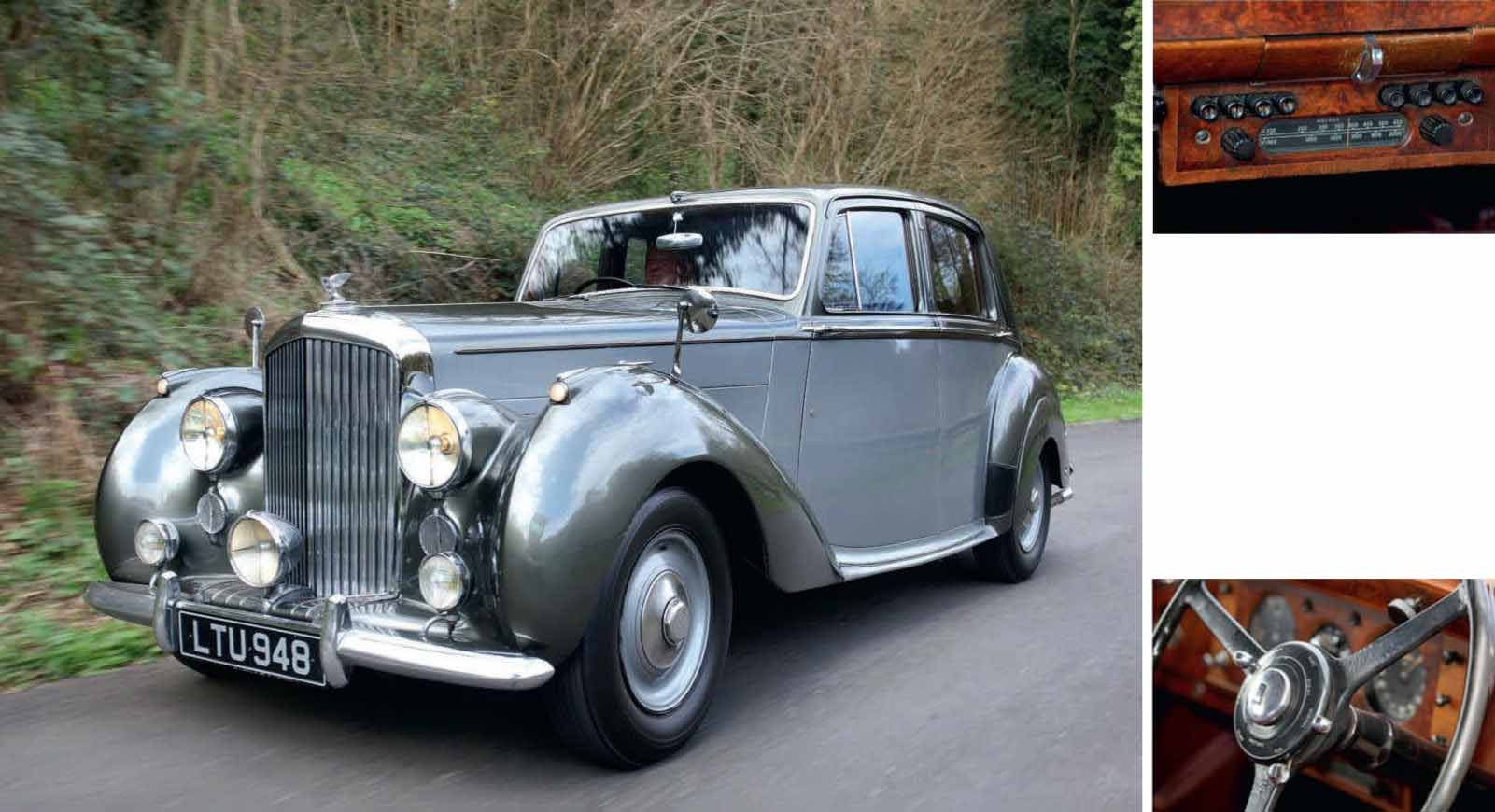
Clockwise: spatted rear arches on MkVI; even the radio has a neat veneered surround; mixture and advance-retard controls only on the earlier Bentley.
‘IT WAS AN OLD MAN’S BARGE WITH NOTHING TO OFFER BUT THIRST AND PITYING LOOKS’
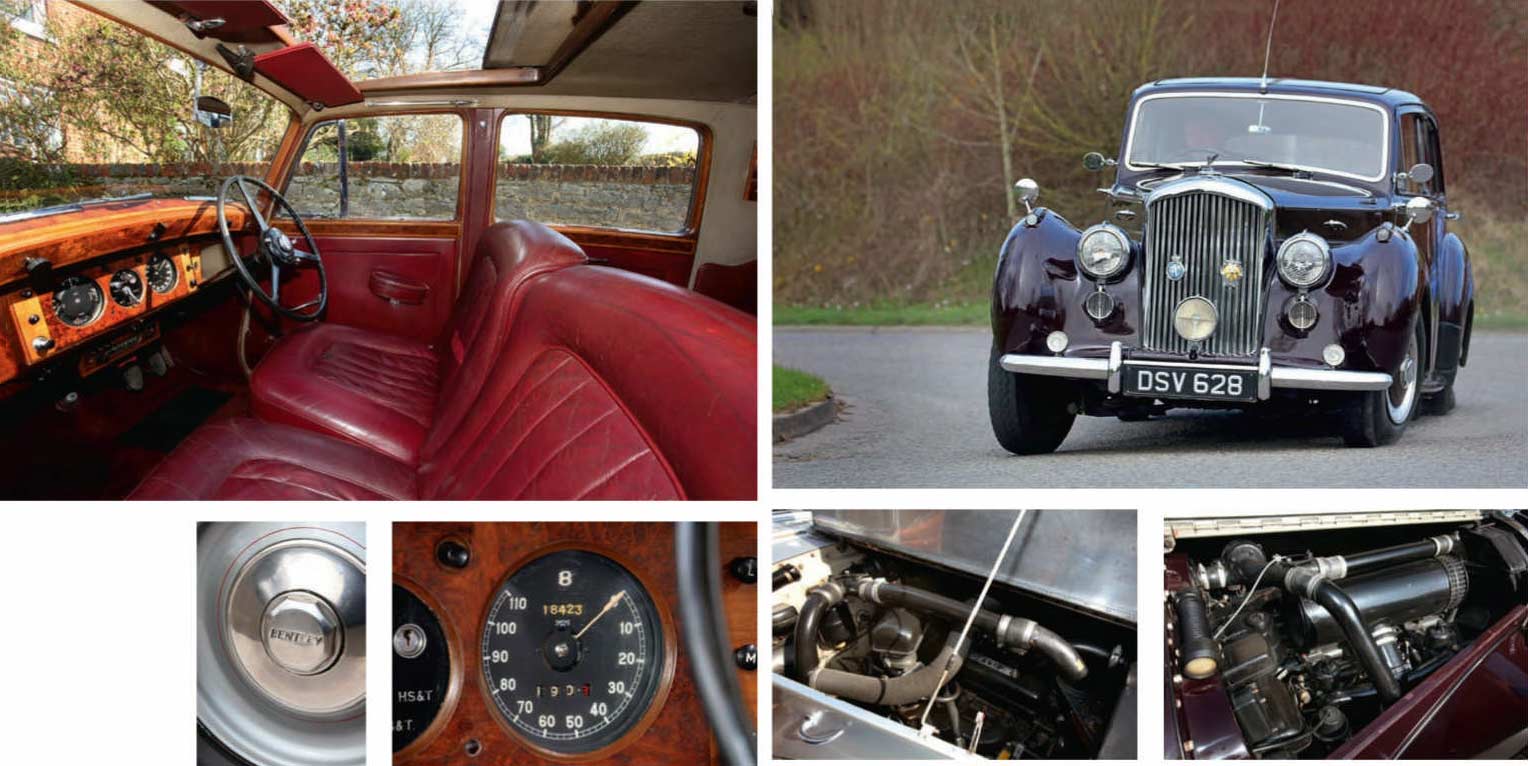
Bentley cornering in a manner not becoming, but it’s hard work with heavy steering. Below: Royces have single carb; Bentleys two – note torch on scuttle. Clockwise: glorious cabin comes to life with sliding head open; Smiths speedo sports ‘B’ motif and reads from right to left; Bentley name also on wheel centre.
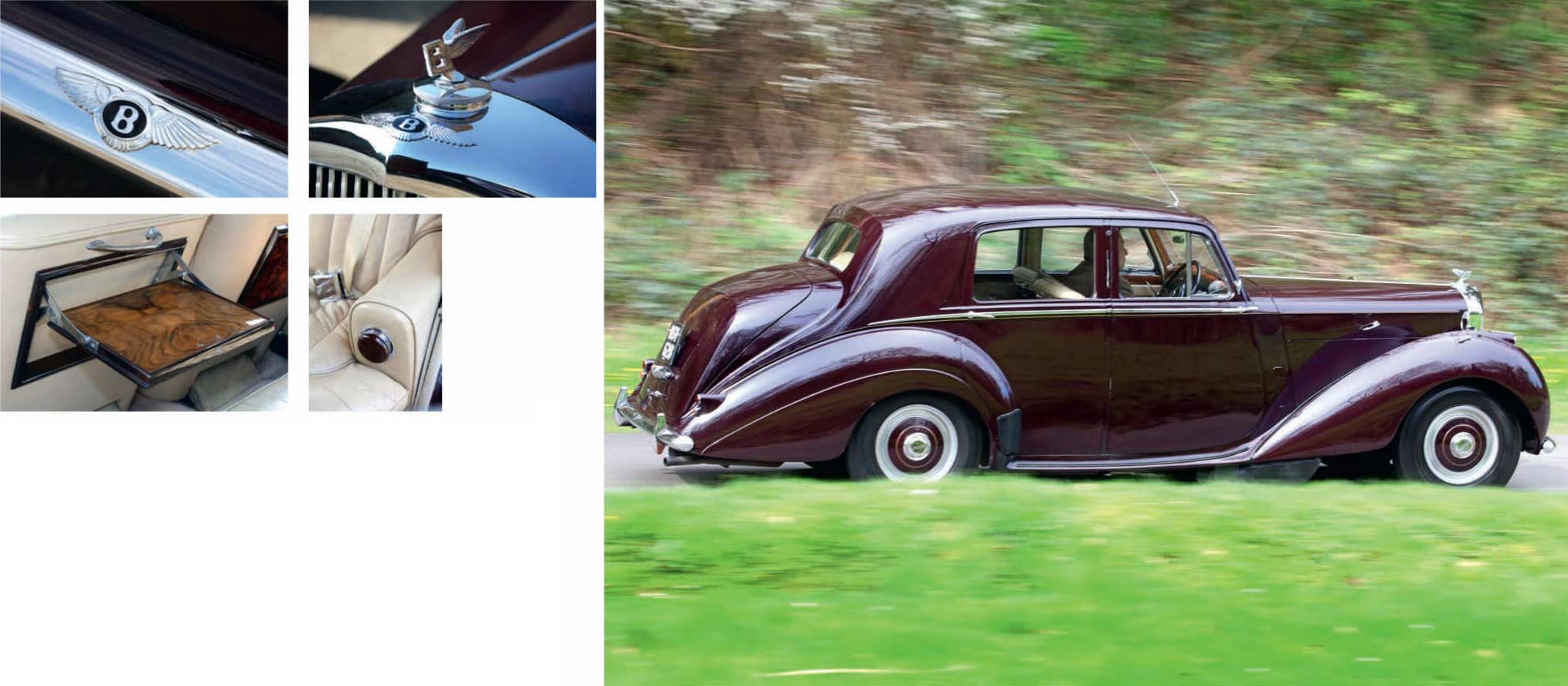
Longer Standard Steel body, with bigger boot, gives the R-type a more elegant profile – almost like a chrysalis for the S-type and Silver Cloud. Clockwise, from above: the famous Flying B adorns the grille top; each armrest hides an ashtray; lovely writing/picnic trays feature in all variants.
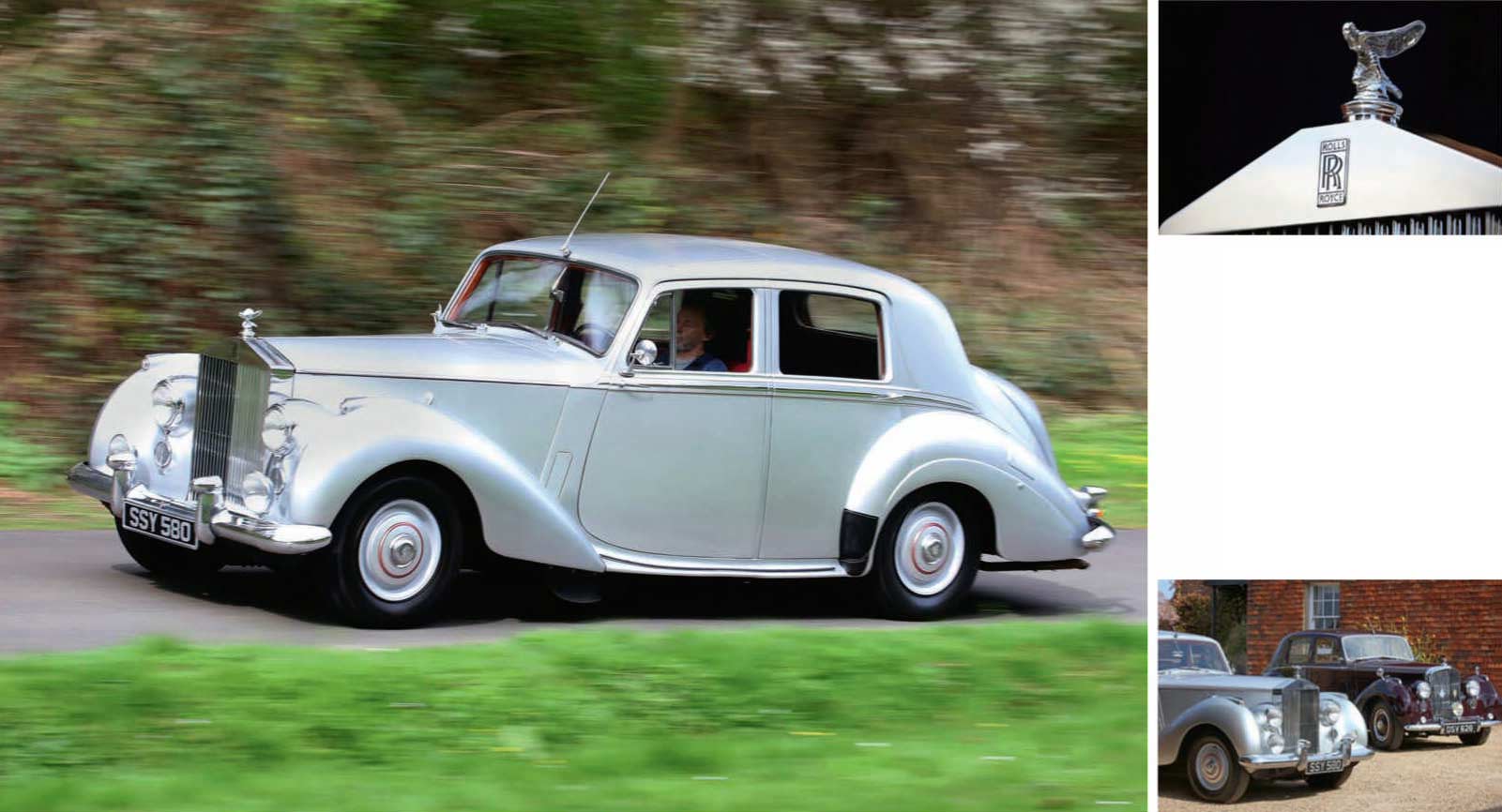
Clockwise: unmistakable radiator grille – topped by the trademark Spirit of Ecstasy – lends the Silver Dawn a more formal air alongside raffish R-type.
‘THE RADIO LOOKS AS IF IT WOULD TRANSMIT A RATTIGAN PLAY ON THE LIGHT PROGRAMME’
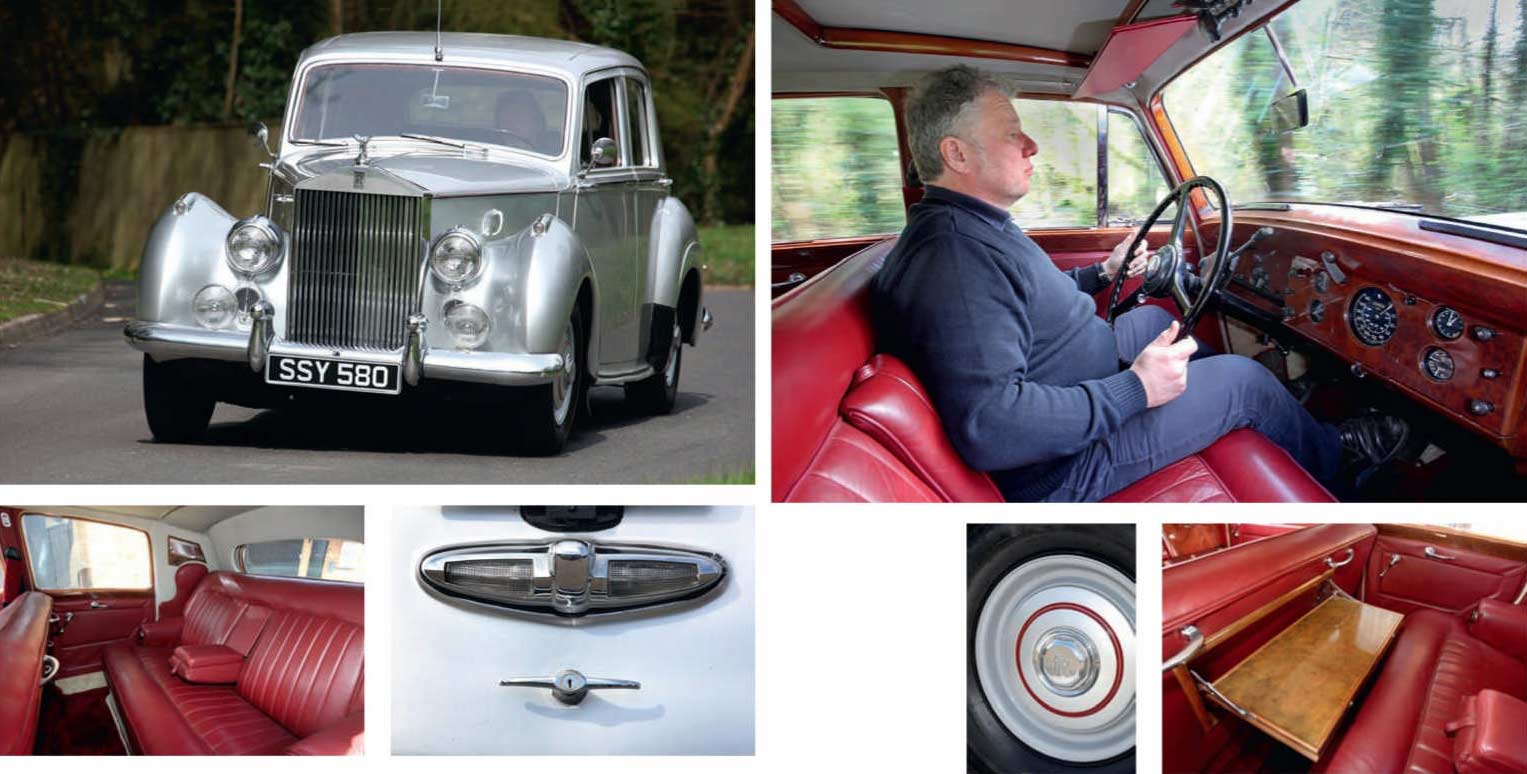
Clockwise: cleverly installed power steering makes Silver Dawn feel nimbler; neat reversing lamps; R-R has similar, but slightly plusher rear cabin. Silver Dawn has a bench (separate seats in sportier Bentleys); speedo, plus clock, oil pressure/coolant temp, fuel and amps; rear cabin similar; R-R symbol.





